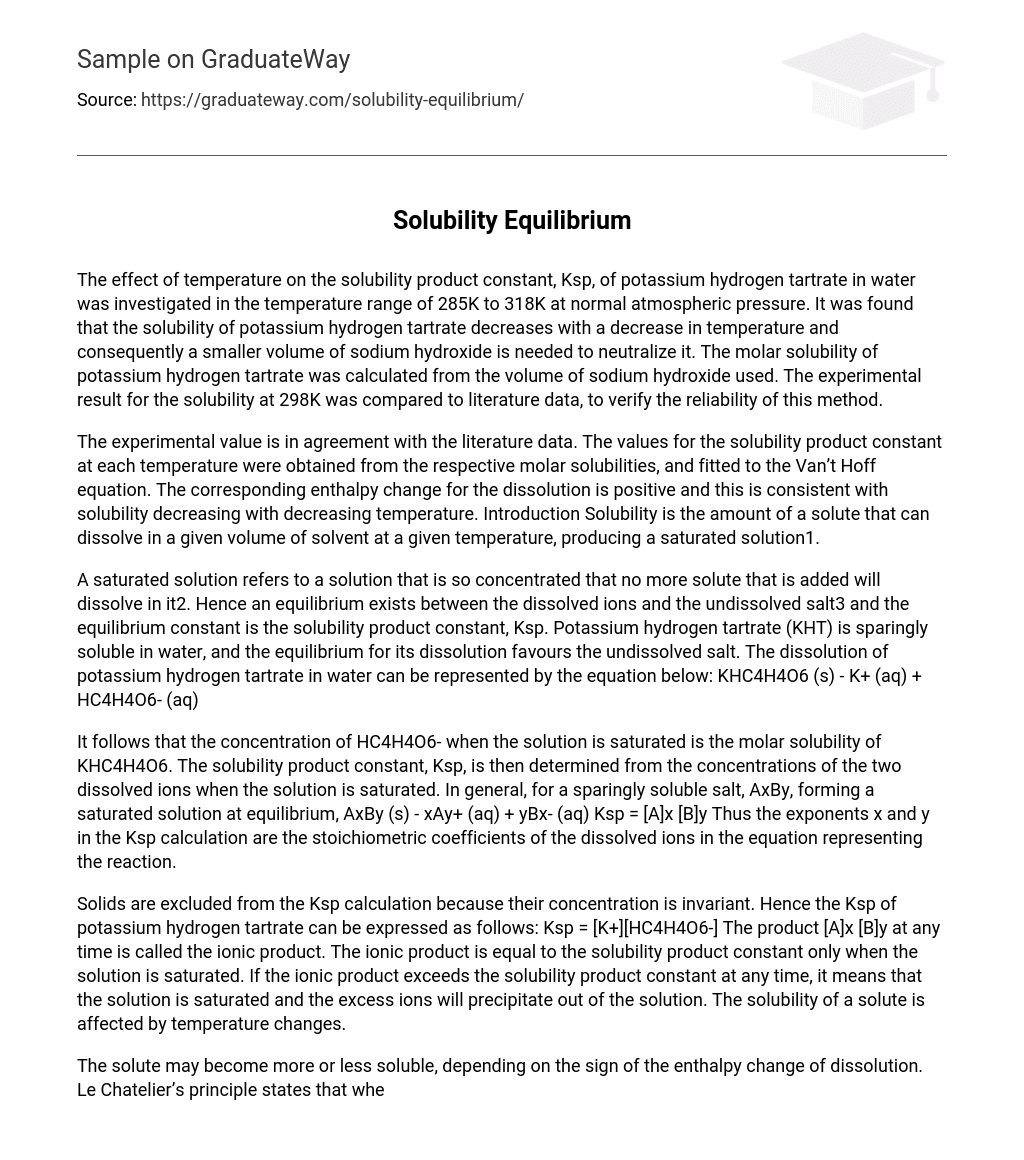The study investigated the influence of temperature (ranging from 285K to 318K) and normal atmospheric pressure on the solubility product constant, Ksp, of potassium hydrogen tartrate in water. The results demonstrated that a reduction in temperature results in a decrease in the solubility of potassium hydrogen tartrate. As a result, less sodium hydroxide is needed for neutralization. The amount of sodium hydroxide used was measured to determine the molar solubility. To confirm the accuracy of this approach, the experimental solubility at 298K was compared with data found in existing literature.
The experimental value agrees with the literature data. The solubility product constant values at different temperatures were obtained from the molar solubilities and matched to the Van’t Hoff equation. The increase in enthalpy for the dissolution is in line with the decrease in solubility at lower temperatures. Solubility pertains to how much of a solute can dissolve in a given volume of solvent at a particular temperature, leading to a saturated solution.
An extremely concentrated solution, known as a saturated solution, cannot dissolve any additional solute. The equilibrium between the dissolved ions and the remaining undissolved salt is determined by the solubility product constant (Ksp). In water, potassium hydrogen tartrate (KHT) has limited solubility, which leads to a higher concentration of undissolved salt. The dissolution of potassium hydrogen tartrate in water can be represented by the equation: KHC4H4O6 (s) – K+ (aq) + HC4H4O6- (aq)
When a solution of KHC4H4O6 is fully saturated, the concentration of HC4H4O6- ions is equal to the molar solubility. In order to find the solubility product constant (Ksp), we measure the concentrations of the dissolved ions when the solution is saturated. When we have a sparingly soluble salt, AxBy, in equilibrium with a completely saturated solution, we use the equation AxBy (s) – xAy+ (aq) + yBx- (aq) to calculate Ksp = [A]x [B]y. The values of x and y represent the stoichiometric coefficients of the dissolved ions in this reaction equation.
The calculation of Ksp does not include solids because their concentration remains constant. Thus, the Ksp for potassium hydrogen tartrate is expressed as: Ksp = [K+][HC4H4O6-]. The product of [A]x[B]y at any given time is called the ionic product. The ionic product only matches the solubility product constant when the solution becomes saturated. If, at any point, the ionic product surpasses the solubility product constant, it indicates saturation and excess ions will precipitate from the solution. Changes in temperature can affect solute solubility.
Le Chatelier’s principle states that the solubility of a solute can be influenced by the enthalpy change when it dissolves. When there is a change in temperature or the concentration of reactants or products, the equilibrium system adjusts to counteract this change. In an endothermic reaction, heat moves from the surroundings to the solution during dissolution. Therefore, if we increase the temperature of the surroundings, Le Chatelier’s principle predicts that more ions will dissolve to balance and remove excess heat.
The solubility of potassium hydrogen tartrate is determined through titration using a base to neutralize the hydrogen tartrate ions. By knowing the concentration of the base, the concentration of hydrogen tartrate ions can be calculated using the equation C1V1 = C2V2. The volume of base used is important in this calculation and can be obtained using an indicator. Phenolphthalein is selected for its distinct color change within its pH range when more base is added. The Ksp of KHC4H4O6 can then be determined using the value of [HC4H4O6-].
The Van’t Hoff equation, InK = -?HRT+?SR, explains the temperature dependence of the solubility product constant. By graphing InKsp versus 1/T using experimental values for temperature (T) and corresponding Ksp values, the standard enthalpy (?H) and entropy change (?S) of the reaction can be determined.
To perform the experiment, saturated solutions of KHC4H4O6 were titrated at various temperatures with a known concentration of NaOH. The NaOH was standardized using dried potassium hydrogen phthalate (KHC8H4O4). A top pan balance accurately measured 0.5g of dried potassium hydrogen phthalate, which was then transferred into a 250mL conical flask. Next, 25 mL of deionized water and 2 drops of phenolphthalein indicator were added to the flask. The solution was continuously swirled while titrating with NaOH until reaching the endpoint. The endpoint was determined when the solution achieved a consistent light pink color. This titration process was repeated multiple times, recording the volume of NaOH used for each trial to calculate the average volume and concentration of the NaOH solution.
The experiment started with the use of a standardized NaOH solution. Initially, 100mL of deionized water was poured into a 250mL conical flask. Then, approximately 1.0-1.5g of KHC4H4O6 was added and the mixture was swirled for 5 minutes. Next, the resulting solution underwent filtration to remove any remaining undissolved KHC4H4O6 particles.
The filtrate was then transferred to another conical flask using a 25.0mL pipette, and two drops of phenolphthalein were included. The next step involved titrating the solution with NaOH while simultaneously recording the volume used for titration. If the temperature fell below room temperature, an ice water bath was prepared to maintain the temperature of the KHC4H4O6 solution.
The solution was filtered in small portions and the temperature of the solution in the filter funnel was measured throughout. 25.0mL portions of the filtrate were titrated with NaOH and the volume of NaOH used was recorded for temperatures 12°C, 19°C, 36°C, and 46°C. For temperatures above room temperature, a hot water bath was set up to maintain higher temperatures during filtration.





